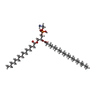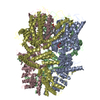+ Open data
Open data
- Basic information
Basic information
| Entry | Database: PDB / ID: 7d4p | ||||||||||||||||||
|---|---|---|---|---|---|---|---|---|---|---|---|---|---|---|---|---|---|---|---|
| Title | Structure of human TRPC5 in complex with clemizole | ||||||||||||||||||
 Components Components | Short transient receptor potential channel 5 | ||||||||||||||||||
 Keywords Keywords | METAL TRANSPORT / clemizole / TRPC5 / trpc | ||||||||||||||||||
| Function / homology |  Function and homology information Function and homology informationregulation of membrane hyperpolarization / phosphatidylserine exposure on apoptotic cell surface / negative regulation of dendrite morphogenesis / Role of second messengers in netrin-1 signaling / store-operated calcium channel activity / inositol 1,4,5 trisphosphate binding / cation channel complex / actinin binding / clathrin binding / TRP channels ...regulation of membrane hyperpolarization / phosphatidylserine exposure on apoptotic cell surface / negative regulation of dendrite morphogenesis / Role of second messengers in netrin-1 signaling / store-operated calcium channel activity / inositol 1,4,5 trisphosphate binding / cation channel complex / actinin binding / clathrin binding / TRP channels / regulation of cytosolic calcium ion concentration / positive regulation of axon extension / positive regulation of neuron differentiation / calcium channel complex / calcium ion transmembrane transport / calcium channel activity / neuron differentiation / calcium ion transport / nervous system development / presynapse / growth cone / actin binding / positive regulation of cytosolic calcium ion concentration / ATPase binding / neuron apoptotic process / neuronal cell body / positive regulation of cell population proliferation / dendrite / plasma membrane Similarity search - Function | ||||||||||||||||||
| Biological species |  Homo sapiens (human) Homo sapiens (human) | ||||||||||||||||||
| Method | ELECTRON MICROSCOPY / single particle reconstruction / cryo EM / Resolution: 2.7 Å | ||||||||||||||||||
 Authors Authors | Chen, L. / Song, K. / Wei, M. / Guo, W. | ||||||||||||||||||
| Funding support |  China, 5items China, 5items
| ||||||||||||||||||
 Citation Citation |  Journal: Elife / Year: 2021 Journal: Elife / Year: 2021Title: Structural basis for human TRPC5 channel inhibition by two distinct inhibitors. Authors: Kangcheng Song / Miao Wei / Wenjun Guo / Li Quan / Yunlu Kang / Jing-Xiang Wu / Lei Chen /  Abstract: TRPC5 channel is a nonselective cation channel that participates in diverse physiological processes. TRPC5 inhibitors show promise in the treatment of anxiety disorder, depression, and kidney disease. ...TRPC5 channel is a nonselective cation channel that participates in diverse physiological processes. TRPC5 inhibitors show promise in the treatment of anxiety disorder, depression, and kidney disease. However, the binding sites and inhibitory mechanism of TRPC5 inhibitors remain elusive. Here, we present the cryo-EM structures of human TRPC5 in complex with two distinct inhibitors, namely clemizole and HC-070, to the resolution of 2.7 Å. The structures reveal that clemizole binds inside the voltage sensor-like domain of each subunit. In contrast, HC-070 is wedged between adjacent subunits and replaces the glycerol group of a putative diacylglycerol molecule near the extracellular side. Moreover, we found mutations in the inhibitor binding pockets altered the potency of inhibitors. These structures suggest that both clemizole and HC-070 exert the inhibitory functions by stabilizing the ion channel in a nonconductive closed state. These results pave the way for further design and optimization of inhibitors targeting human TRPC5. | ||||||||||||||||||
| History |
|
- Structure visualization
Structure visualization
| Movie |
 Movie viewer Movie viewer |
|---|---|
| Structure viewer | Molecule:  Molmil Molmil Jmol/JSmol Jmol/JSmol |
- Downloads & links
Downloads & links
- Download
Download
| PDBx/mmCIF format |  7d4p.cif.gz 7d4p.cif.gz | 550.4 KB | Display |  PDBx/mmCIF format PDBx/mmCIF format |
|---|---|---|---|---|
| PDB format |  pdb7d4p.ent.gz pdb7d4p.ent.gz | 453.8 KB | Display |  PDB format PDB format |
| PDBx/mmJSON format |  7d4p.json.gz 7d4p.json.gz | Tree view |  PDBx/mmJSON format PDBx/mmJSON format | |
| Others |  Other downloads Other downloads |
-Validation report
| Summary document |  7d4p_validation.pdf.gz 7d4p_validation.pdf.gz | 2.2 MB | Display |  wwPDB validaton report wwPDB validaton report |
|---|---|---|---|---|
| Full document |  7d4p_full_validation.pdf.gz 7d4p_full_validation.pdf.gz | 2.2 MB | Display | |
| Data in XML |  7d4p_validation.xml.gz 7d4p_validation.xml.gz | 83.9 KB | Display | |
| Data in CIF |  7d4p_validation.cif.gz 7d4p_validation.cif.gz | 116.4 KB | Display | |
| Arichive directory |  https://data.pdbj.org/pub/pdb/validation_reports/d4/7d4p https://data.pdbj.org/pub/pdb/validation_reports/d4/7d4p ftp://data.pdbj.org/pub/pdb/validation_reports/d4/7d4p ftp://data.pdbj.org/pub/pdb/validation_reports/d4/7d4p | HTTPS FTP |
-Related structure data
| Related structure data |  30575MC  7d4qC  7e4tC M: map data used to model this data C: citing same article ( |
|---|---|
| Similar structure data |
- Links
Links
- Assembly
Assembly
| Deposited unit | 
|
|---|---|
| 1 |
|
- Components
Components
-Protein , 1 types, 4 molecules ABCD
| #1: Protein | Mass: 88848.578 Da / Num. of mol.: 4 Source method: isolated from a genetically manipulated source Source: (gene. exp.)  Homo sapiens (human) / Gene: TRPC5, TRP5 / Production host: Homo sapiens (human) / Gene: TRPC5, TRP5 / Production host:  Homo sapiens (human) / References: UniProt: Q9UL62 Homo sapiens (human) / References: UniProt: Q9UL62 |
|---|
-Non-polymers , 7 types, 28 molecules 












| #2: Chemical | ChemComp-GX0 / #3: Chemical | ChemComp-PTY / #4: Chemical | ChemComp-POV / ( #5: Chemical | ChemComp-Y01 / #6: Chemical | ChemComp-ZN / #7: Chemical | ChemComp-CA / #8: Chemical | ChemComp-YZY / ( |
|---|
-Details
| Has ligand of interest | Y |
|---|---|
| Has protein modification | Y |
-Experimental details
-Experiment
| Experiment | Method: ELECTRON MICROSCOPY |
|---|---|
| EM experiment | Aggregation state: PARTICLE / 3D reconstruction method: single particle reconstruction |
- Sample preparation
Sample preparation
| Component | Name: human transient receptor potential channel 5 tetramer / Type: COMPLEX / Entity ID: #1 / Source: RECOMBINANT |
|---|---|
| Source (natural) | Organism:  Homo sapiens (human) Homo sapiens (human) |
| Source (recombinant) | Organism:  Homo sapiens (human) Homo sapiens (human) |
| Buffer solution | pH: 7.5 |
| Specimen | Embedding applied: NO / Shadowing applied: NO / Staining applied: NO / Vitrification applied: YES |
| Vitrification | Cryogen name: ETHANE |
- Electron microscopy imaging
Electron microscopy imaging
| Experimental equipment |  Model: Titan Krios / Image courtesy: FEI Company |
|---|---|
| Microscopy | Model: FEI TITAN KRIOS |
| Electron gun | Electron source:  FIELD EMISSION GUN / Accelerating voltage: 300 kV / Illumination mode: FLOOD BEAM FIELD EMISSION GUN / Accelerating voltage: 300 kV / Illumination mode: FLOOD BEAM |
| Electron lens | Mode: BRIGHT FIELD |
| Image recording | Electron dose: 50 e/Å2 / Film or detector model: GATAN K2 QUANTUM (4k x 4k) |
- Processing
Processing
| EM software | Name: cryoSPARC / Version: V1 / Category: 3D reconstruction |
|---|---|
| CTF correction | Type: NONE |
| Symmetry | Point symmetry: C4 (4 fold cyclic) |
| 3D reconstruction | Resolution: 2.7 Å / Resolution method: FSC 0.143 CUT-OFF / Num. of particles: 90357 / Symmetry type: POINT |
 Movie
Movie Controller
Controller















 PDBj
PDBj








